[English] 日本語
 Yorodumi
Yorodumi- PDB-3mrf: Crystal Structure of MHC class I HLA-A2 molecule complexed with E... -
+ Open data
Open data
- Basic information
Basic information
| Entry | Database: PDB / ID: 3mrf | ||||||
|---|---|---|---|---|---|---|---|
| Title | Crystal Structure of MHC class I HLA-A2 molecule complexed with EBV bmlf1-280-288 nonapeptide T4P variant | ||||||
 Components Components |
| ||||||
 Keywords Keywords |  IMMUNE SYSTEM / IMMUNE SYSTEM /  MHC class I / HLA / MHC class I / HLA /  IMMUNE RESPONSE / IMMUNE RESPONSE /  NONAPEPTIDE / VIRAL PEPTIDE / NONAPEPTIDE / VIRAL PEPTIDE /  EPSTEIN-BARR VIRUS / BMLF1 PROTEIN / EB2 protein EPSTEIN-BARR VIRUS / BMLF1 PROTEIN / EB2 protein | ||||||
| Function / homology |  Function and homology information Function and homology informationsymbiont-mediated suppression of host PKR/eIFalpha signaling / protein serine/threonine kinase inhibitor activity / T cell mediated cytotoxicity directed against tumor cell target / antigen processing and presentation of endogenous peptide antigen via MHC class I via ER pathway, TAP-dependent / positive regulation of memory T cell activation / TAP complex binding / antigen processing and presentation of exogenous peptide antigen via MHC class I / Golgi medial cisterna / positive regulation of CD8-positive, alpha-beta T cell activation / CD8-positive, alpha-beta T cell activation ...symbiont-mediated suppression of host PKR/eIFalpha signaling / protein serine/threonine kinase inhibitor activity / T cell mediated cytotoxicity directed against tumor cell target / antigen processing and presentation of endogenous peptide antigen via MHC class I via ER pathway, TAP-dependent / positive regulation of memory T cell activation / TAP complex binding / antigen processing and presentation of exogenous peptide antigen via MHC class I / Golgi medial cisterna / positive regulation of CD8-positive, alpha-beta T cell activation / CD8-positive, alpha-beta T cell activation / positive regulation of CD8-positive, alpha-beta T cell proliferation / CD8 receptor binding / mRNA transport / endoplasmic reticulum exit site /  beta-2-microglobulin binding / TAP binding / beta-2-microglobulin binding / TAP binding /  protection from natural killer cell mediated cytotoxicity / antigen processing and presentation of endogenous peptide antigen via MHC class I via ER pathway, TAP-independent / antigen processing and presentation of endogenous peptide antigen via MHC class Ib / detection of bacterium / protection from natural killer cell mediated cytotoxicity / antigen processing and presentation of endogenous peptide antigen via MHC class I via ER pathway, TAP-independent / antigen processing and presentation of endogenous peptide antigen via MHC class Ib / detection of bacterium /  T cell receptor binding / positive regulation of ferrous iron binding / positive regulation of transferrin receptor binding / positive regulation of receptor binding / early endosome lumen / Nef mediated downregulation of MHC class I complex cell surface expression / DAP12 interactions / negative regulation of receptor binding / lumenal side of endoplasmic reticulum membrane / Endosomal/Vacuolar pathway / Antigen Presentation: Folding, assembly and peptide loading of class I MHC / antigen processing and presentation of exogenous protein antigen via MHC class Ib, TAP-dependent / cellular response to iron(III) ion / negative regulation of forebrain neuron differentiation / ER to Golgi transport vesicle membrane / peptide antigen assembly with MHC class I protein complex / response to molecule of bacterial origin / T cell receptor binding / positive regulation of ferrous iron binding / positive regulation of transferrin receptor binding / positive regulation of receptor binding / early endosome lumen / Nef mediated downregulation of MHC class I complex cell surface expression / DAP12 interactions / negative regulation of receptor binding / lumenal side of endoplasmic reticulum membrane / Endosomal/Vacuolar pathway / Antigen Presentation: Folding, assembly and peptide loading of class I MHC / antigen processing and presentation of exogenous protein antigen via MHC class Ib, TAP-dependent / cellular response to iron(III) ion / negative regulation of forebrain neuron differentiation / ER to Golgi transport vesicle membrane / peptide antigen assembly with MHC class I protein complex / response to molecule of bacterial origin /  regulation of erythrocyte differentiation / regulation of iron ion transport / MHC class I peptide loading complex / HFE-transferrin receptor complex / T cell mediated cytotoxicity / cellular response to iron ion / antigen processing and presentation of endogenous peptide antigen via MHC class I / positive regulation of T cell cytokine production / MHC class I protein complex / multicellular organismal-level iron ion homeostasis / positive regulation of T cell mediated cytotoxicity / peptide antigen assembly with MHC class II protein complex / negative regulation of neurogenesis / MHC class II protein complex / positive regulation of receptor-mediated endocytosis / cellular response to nicotine / recycling endosome membrane / specific granule lumen / phagocytic vesicle membrane / peptide antigen binding / positive regulation of cellular senescence / antigen processing and presentation of exogenous peptide antigen via MHC class II / Immunoregulatory interactions between a Lymphoid and a non-Lymphoid cell / positive regulation of immune response / negative regulation of epithelial cell proliferation / Interferon gamma signaling / positive regulation of T cell activation / Modulation by Mtb of host immune system / Interferon alpha/beta signaling / positive regulation of type II interferon production / sensory perception of smell / E3 ubiquitin ligases ubiquitinate target proteins / negative regulation of neuron projection development / tertiary granule lumen / DAP12 signaling / MHC class II protein complex binding / T cell differentiation in thymus / late endosome membrane / positive regulation of protein binding / ER-Phagosome pathway / antibacterial humoral response / iron ion transport / T cell receptor signaling pathway / protein refolding / early endosome membrane / protein homotetramerization / intracellular iron ion homeostasis / host cell cytoplasm / amyloid fibril formation / learning or memory / defense response to Gram-positive bacterium / regulation of erythrocyte differentiation / regulation of iron ion transport / MHC class I peptide loading complex / HFE-transferrin receptor complex / T cell mediated cytotoxicity / cellular response to iron ion / antigen processing and presentation of endogenous peptide antigen via MHC class I / positive regulation of T cell cytokine production / MHC class I protein complex / multicellular organismal-level iron ion homeostasis / positive regulation of T cell mediated cytotoxicity / peptide antigen assembly with MHC class II protein complex / negative regulation of neurogenesis / MHC class II protein complex / positive regulation of receptor-mediated endocytosis / cellular response to nicotine / recycling endosome membrane / specific granule lumen / phagocytic vesicle membrane / peptide antigen binding / positive regulation of cellular senescence / antigen processing and presentation of exogenous peptide antigen via MHC class II / Immunoregulatory interactions between a Lymphoid and a non-Lymphoid cell / positive regulation of immune response / negative regulation of epithelial cell proliferation / Interferon gamma signaling / positive regulation of T cell activation / Modulation by Mtb of host immune system / Interferon alpha/beta signaling / positive regulation of type II interferon production / sensory perception of smell / E3 ubiquitin ligases ubiquitinate target proteins / negative regulation of neuron projection development / tertiary granule lumen / DAP12 signaling / MHC class II protein complex binding / T cell differentiation in thymus / late endosome membrane / positive regulation of protein binding / ER-Phagosome pathway / antibacterial humoral response / iron ion transport / T cell receptor signaling pathway / protein refolding / early endosome membrane / protein homotetramerization / intracellular iron ion homeostasis / host cell cytoplasm / amyloid fibril formation / learning or memory / defense response to Gram-positive bacterium /  immune response / Amyloid fiber formation / lysosomal membrane / external side of plasma membrane / immune response / Amyloid fiber formation / lysosomal membrane / external side of plasma membrane /  endoplasmic reticulum lumen / endoplasmic reticulum lumen /  Golgi membrane / Golgi membrane /  signaling receptor binding / signaling receptor binding /  focal adhesion / focal adhesion /  innate immune response / symbiont-mediated suppression of host type I interferon-mediated signaling pathway / host cell nucleus / Neutrophil degranulation innate immune response / symbiont-mediated suppression of host type I interferon-mediated signaling pathway / host cell nucleus / Neutrophil degranulationSimilarity search - Function | ||||||
| Biological species |   Homo sapiens (human) Homo sapiens (human)  Epstein-Barr virus EBV (Epstein-Barr virus) Epstein-Barr virus EBV (Epstein-Barr virus) | ||||||
| Method |  X-RAY DIFFRACTION / X-RAY DIFFRACTION /  SYNCHROTRON / SYNCHROTRON /  MOLECULAR REPLACEMENT / Resolution: 2.3 Å MOLECULAR REPLACEMENT / Resolution: 2.3 Å | ||||||
 Authors Authors | Trudel, E. / Gras, S. / Chouquet, A. / Debeaupuis, E. / Echasserieau, K. / Saulquin, X. / Bonneville, M. / Housset, D. | ||||||
 Citation Citation |  Journal: To be Published Journal: To be PublishedTitle: Crystal Structure of MHC class I HLA-A2 molecule complexed with EBV bmlf1-280-288 nonapeptide T4P variant Authors: Trudel, E. / Gras, S. / Chouquet, A. / Debeaupuis, E. / Echasserieau, K. / Saulquin, X. / Bonneville, M. / Housset, D. | ||||||
| History |
|
- Structure visualization
Structure visualization
| Structure viewer | Molecule:  Molmil Molmil Jmol/JSmol Jmol/JSmol |
|---|
- Downloads & links
Downloads & links
- Download
Download
| PDBx/mmCIF format |  3mrf.cif.gz 3mrf.cif.gz | 97.5 KB | Display |  PDBx/mmCIF format PDBx/mmCIF format |
|---|---|---|---|---|
| PDB format |  pdb3mrf.ent.gz pdb3mrf.ent.gz | 72.8 KB | Display |  PDB format PDB format |
| PDBx/mmJSON format |  3mrf.json.gz 3mrf.json.gz | Tree view |  PDBx/mmJSON format PDBx/mmJSON format | |
| Others |  Other downloads Other downloads |
-Validation report
| Arichive directory |  https://data.pdbj.org/pub/pdb/validation_reports/mr/3mrf https://data.pdbj.org/pub/pdb/validation_reports/mr/3mrf ftp://data.pdbj.org/pub/pdb/validation_reports/mr/3mrf ftp://data.pdbj.org/pub/pdb/validation_reports/mr/3mrf | HTTPS FTP |
|---|
-Related structure data
| Related structure data | 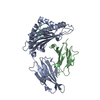 3mreS S: Starting model for refinement |
|---|---|
| Similar structure data |
- Links
Links
- Assembly
Assembly
| Deposited unit | 
| ||||||||
|---|---|---|---|---|---|---|---|---|---|
| 1 |
| ||||||||
| Unit cell |
|
- Components
Components
| #1: Protein | Mass: 34008.711 Da / Num. of mol.: 1 / Fragment: HLA-A*0201 alpha chain, UNP resiude 25-300 / Mutation: A245V Source method: isolated from a genetically manipulated source Details: C-terminal biotin acceptor peptide sequence tag (GSLHHILDAQKMVWNHR) Source: (gene. exp.)   Homo sapiens (human) / Gene: HLA, HLA-A, HLAA / Plasmid: pHN1 / Production host: Homo sapiens (human) / Gene: HLA, HLA-A, HLAA / Plasmid: pHN1 / Production host:   Escherichia coli (E. coli) / Strain (production host): X90F LAQQ1 / References: UniProt: P01892, UniProt: P04439*PLUS Escherichia coli (E. coli) / Strain (production host): X90F LAQQ1 / References: UniProt: P01892, UniProt: P04439*PLUS |
|---|---|
| #2: Protein |  Beta-2 microglobulin / Beta-2-microglobulin form pI 5.3 Beta-2 microglobulin / Beta-2-microglobulin form pI 5.3Mass: 11879.356 Da / Num. of mol.: 1 Source method: isolated from a genetically manipulated source Source: (gene. exp.)   Homo sapiens (human) / Gene: B2M, BETA-2 MICROGLUBULIN, CDABP0092, HDCMA22P / Plasmid: pHN1 / Production host: Homo sapiens (human) / Gene: B2M, BETA-2 MICROGLUBULIN, CDABP0092, HDCMA22P / Plasmid: pHN1 / Production host:   Escherichia coli (E. coli) / Strain (production host): X90F LAQQ1 / References: UniProt: P61769 Escherichia coli (E. coli) / Strain (production host): X90F LAQQ1 / References: UniProt: P61769 |
| #3: Protein/peptide | Mass: 916.202 Da / Num. of mol.: 1 Fragment: EB2 PROTEIN FRAGMENT (BMLF1 280-288), UNP residues 300-308 Mutation: T4P / Source method: obtained synthetically Details: Variant of a sequence occuring in Epstein-Barr virus bmlf1 protein Source: (synth.)   Epstein-Barr virus EBV (Epstein-Barr virus) Epstein-Barr virus EBV (Epstein-Barr virus)References: UniProt: Q3KSU1 |
| #4: Water | ChemComp-HOH /  Water Water |
| Compound details | EBV BSFL2 AND BMLF1 ORFS ARE JOINED TO ENCODE THE EB2 PROTEIN. EB2 PROTEIN IS ALSO CALLED ...EBV BSFL2 AND BMLF1 ORFS ARE JOINED TO ENCODE THE EB2 PROTEIN. EB2 PROTEIN IS ALSO CALLED BSFL2/BMLF1, MTA OR SM. |
| Sequence details | THE GLCTLVAML NONAPEPTIDE WAS FIRST IDENTIFIED AS AN HLA-A2 RESTRICTED T CELL EPITOPE ON A ...THE GLCTLVAML NONAPEPTID |
-Experimental details
-Experiment
| Experiment | Method:  X-RAY DIFFRACTION / Number of used crystals: 1 X-RAY DIFFRACTION / Number of used crystals: 1 |
|---|
- Sample preparation
Sample preparation
| Crystal | Density Matthews: 2.26 Å3/Da / Density % sol: 45.56 % |
|---|---|
Crystal grow | Temperature: 293 K / Method: vapor diffusion, hanging drop / pH: 6.5 Details: 12% PEG 6000, 0.1M NaCacodylate, 0.1M NaCl, 7.5mg/ml protein conc., pH 6.5, VAPOR DIFFUSION, HANGING DROP, temperature 293K |
-Data collection
| Diffraction | Mean temperature: 100 K | ||||||||||||||||||||||||||||||||||||||||||||||||||||||||||||||||||||||||||||||||||||||||||||||||||||||||||||||||
|---|---|---|---|---|---|---|---|---|---|---|---|---|---|---|---|---|---|---|---|---|---|---|---|---|---|---|---|---|---|---|---|---|---|---|---|---|---|---|---|---|---|---|---|---|---|---|---|---|---|---|---|---|---|---|---|---|---|---|---|---|---|---|---|---|---|---|---|---|---|---|---|---|---|---|---|---|---|---|---|---|---|---|---|---|---|---|---|---|---|---|---|---|---|---|---|---|---|---|---|---|---|---|---|---|---|---|---|---|---|---|---|---|---|
| Diffraction source | Source:  SYNCHROTRON / Site: SYNCHROTRON / Site:  ESRF ESRF  / Beamline: ID14-2 / Wavelength: 0.933 Å / Beamline: ID14-2 / Wavelength: 0.933 Å | ||||||||||||||||||||||||||||||||||||||||||||||||||||||||||||||||||||||||||||||||||||||||||||||||||||||||||||||||
| Detector | Type: ADSC QUANTUM 4 / Detector: CCD / Date: Jul 21, 2006 | ||||||||||||||||||||||||||||||||||||||||||||||||||||||||||||||||||||||||||||||||||||||||||||||||||||||||||||||||
| Radiation | Protocol: SINGLE WAVELENGTH / Monochromatic (M) / Laue (L): M / Scattering type: x-ray | ||||||||||||||||||||||||||||||||||||||||||||||||||||||||||||||||||||||||||||||||||||||||||||||||||||||||||||||||
| Radiation wavelength | Wavelength : 0.933 Å / Relative weight: 1 : 0.933 Å / Relative weight: 1 | ||||||||||||||||||||||||||||||||||||||||||||||||||||||||||||||||||||||||||||||||||||||||||||||||||||||||||||||||
| Reflection | Resolution: 2.3→50 Å / Num. obs: 18522 / % possible obs: 99.3 % / Observed criterion σ(I): -3 / Redundancy: 3.74 % / Biso Wilson estimate: 23.69 Å2 / Rmerge(I) obs: 0.11 / Net I/σ(I): 11.8 | ||||||||||||||||||||||||||||||||||||||||||||||||||||||||||||||||||||||||||||||||||||||||||||||||||||||||||||||||
| Reflection shell | Diffraction-ID: 1
|
- Processing
Processing
| Software |
| |||||||||||||||||||||||||||||||||||||||||||||||||||||||||||||||||
|---|---|---|---|---|---|---|---|---|---|---|---|---|---|---|---|---|---|---|---|---|---|---|---|---|---|---|---|---|---|---|---|---|---|---|---|---|---|---|---|---|---|---|---|---|---|---|---|---|---|---|---|---|---|---|---|---|---|---|---|---|---|---|---|---|---|---|
| Refinement | Method to determine structure : :  MOLECULAR REPLACEMENT MOLECULAR REPLACEMENTStarting model: PDB ENTRY 3MRE Resolution: 2.3→15 Å / Cor.coef. Fo:Fc: 0.925 / Cor.coef. Fo:Fc free: 0.869 / Occupancy max: 1 / Occupancy min: 0.4 / SU B: 5.319 / SU ML: 0.13 / Cross valid method: THROUGHOUT / σ(F): 0 / ESU R Free: 0.287 / Stereochemistry target values: MAXIMUM LIKELIHOOD Details: U VALUES: REFINED INDIVIDUALLY; 10 to 20 refinement cycles with all observed reflections were performed at the end of the refinement procedure, in order to obtain the most accurate model. ...Details: U VALUES: REFINED INDIVIDUALLY; 10 to 20 refinement cycles with all observed reflections were performed at the end of the refinement procedure, in order to obtain the most accurate model. Rwork and Rfree values corresponds to the coordinates just before these very last cycles.
| |||||||||||||||||||||||||||||||||||||||||||||||||||||||||||||||||
| Solvent computation | Ion probe radii: 0.8 Å / Shrinkage radii: 0.8 Å / VDW probe radii: 1.4 Å / Solvent model: BABINET MODEL WITH MASK | |||||||||||||||||||||||||||||||||||||||||||||||||||||||||||||||||
| Displacement parameters | Biso max: 56.86 Å2 / Biso mean: 17.549 Å2 / Biso min: 2 Å2
| |||||||||||||||||||||||||||||||||||||||||||||||||||||||||||||||||
| Refinement step | Cycle: LAST / Resolution: 2.3→15 Å
| |||||||||||||||||||||||||||||||||||||||||||||||||||||||||||||||||
| Refine LS restraints |
| |||||||||||||||||||||||||||||||||||||||||||||||||||||||||||||||||
| LS refinement shell | Resolution: 2.3→2.358 Å / Total num. of bins used: 20
|
 Movie
Movie Controller
Controller


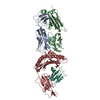

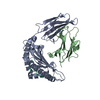
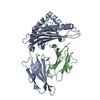
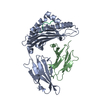
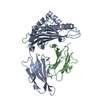
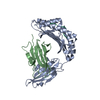
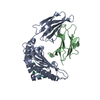

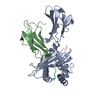

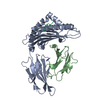




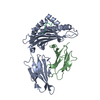






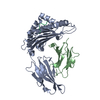

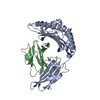
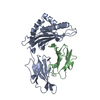





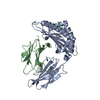

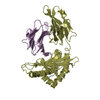

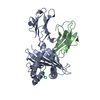
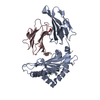



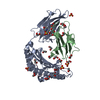
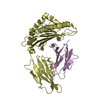

 PDBj
PDBj


